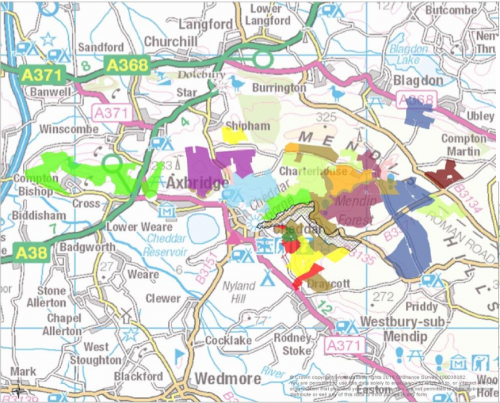Ref: CSFF110005
Lead: Joanna Lawrence, joanna.lawrence@somersetwildlife.org
Group members: 13
Length of agreement: 5
Area of group (Hectares): 2577
The Group will deliver the following CS priorities for Mendip Hills:
BIODIVERSITY:
Restoration or maintenance of SSSIs: 7 of the 13 landowners in the Group own SSSI land. Restoration or maintenance of priority habitats: lowland heathland, lowland calcareous grassland, lowland dry acid grassland, lowland meadows, traditional orchards, ancient and native woodlands, calaminarian grassland and arable field margins. Creation of traditional orchards. Habitat creation to extend or link priority habitat to increase connectivity and reduce fragmentation guided by ecological networks: Management to meet the needs of small pearl bordered fritillary, marsh fritillary, greater and lesser horseshoe bats and Duke of Burgundy Management to maintain or enhance the conditions for woodland birds Increasing flowers on grassland to benefit wild pollinators and other farm wildlife: This will be achieved both through restoration of core priority habitats and through the use of herb-rich leys. Managing hedgerows and other key farm habitats
WATER:
Improving water quality by controlling the source or movement of potential pollutants: Many of the activities described above will improve water quality. For example herb rich leys can fix nitrogen and are deeper rooting than conventional leys so will over time reduce fertiliser inputs and improved soil structure. We will also commission training on soil and nutrient management in consultation with the local CSF team.
HISTORIC ENVIRONMENT:
Ensuring the long-term survival of historic environment features: Landowners in the group have 55 Scheduled Monuments on their land.
WOODLAND:
Woodland management: 10 members of the Facilitation Group have options for woodland management. LANDSCAPE: Restoring landscape features: This will include hedgerow and stone wall restoration.
MULTIPLE ENVIRONMENTAL BENEFITS:
Restoring and enhancing boundary features to intercept run-off, increase soil infiltration rates and reduce soil erosion, restoring or creating legume and herb rich grassland in the western part of the Mendip Hills and enhancing existing woodlands.

